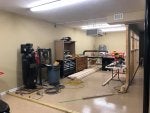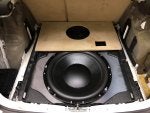I'm going to preface this thread with the fact that I'm NOT a shop.
I don't run a business, I'm just lucky enough to have enough garage/shop space at my house that will allow me to build/house my own cars and work on cars for friends.
The cars I get are typically cars that are the big projects that sit in the back of a regular car audio shop and collect dust. I have one that was shipped down from PA because the owner had spent so much time and money on the vehicle only to be disappointed in both the sound and quality of work. He knows I have a high level of attention to detail and won't let anything leave that I'm not happy with.
Other times I'll have people contact me to do things that they've been told can't be done.
When we first moved to the place (a couple of years ago this past March) I had a guy that wanted to have a vehicle delivered here. Told him to wait because I needed to get the wood shop built.
He didn't wait. lol I ended up going through his build while trying to make progress on the wood shop. Then the Audi showed up.
So before I go too far...
First few pics are of "the shop". This is the first floor of the house.
That's the front door on the right. The glass door goes upstairs to the living area.
![305334 305334]()
From the front door you see the 3-car bay.
![305336 305336]()
From the back corner of the 3-car bay looking toward the front door. you can also see the 2-car bay with the yellow-ish lighting in the distance. The area on the left of the image is where I planned to put the wood shop. In this state the place was a 7-car garage.
![305338 305338]()
The garage sink, some cabinets, and a 1/2 bath is down here. The walkway to the left of the sink/cabinet area was originally a doorway. The current 2-car bay was a carport when the house was built. The open wall on the left was an exterior wall when the carport was open.
![305339 305339]()
This is a shot standing inside what I planned to be the wood shop and looking out into the rest of the garage.
![305340 305340]()
Looking from the front of the 2-car bay towards the long, open wall and the space behind it where the wood shop would go.
![305341 305341]()
Getting tools situated and started work framing the new walls.
![305343 305343]()
![305344 305344]()
I decided to go larger than my original plan and 45 one corner of the shop. That gave me the ability to put a large double door opening in. Thanks to COVID the doors and windows I want are out of stock.
![305347 305347]()
So I'm re-uploading images that disappeared and now it'll only allow 10 images.
There's a full shop build album here. It's still a work in progress.
So anyway, that's a quick rundown of "the shop". I had two cars brought here before I could get fully set up. The Audi is the first "big" project. That's the focus of this thread.
I call it Batdog Garage because my service dog is a German Shepherd the Batdog nickname stuck.
Audi info incoming...
I don't run a business, I'm just lucky enough to have enough garage/shop space at my house that will allow me to build/house my own cars and work on cars for friends.
The cars I get are typically cars that are the big projects that sit in the back of a regular car audio shop and collect dust. I have one that was shipped down from PA because the owner had spent so much time and money on the vehicle only to be disappointed in both the sound and quality of work. He knows I have a high level of attention to detail and won't let anything leave that I'm not happy with.
Other times I'll have people contact me to do things that they've been told can't be done.
When we first moved to the place (a couple of years ago this past March) I had a guy that wanted to have a vehicle delivered here. Told him to wait because I needed to get the wood shop built.
He didn't wait. lol I ended up going through his build while trying to make progress on the wood shop. Then the Audi showed up.
So before I go too far...
First few pics are of "the shop". This is the first floor of the house.
That's the front door on the right. The glass door goes upstairs to the living area.
From the front door you see the 3-car bay.
From the back corner of the 3-car bay looking toward the front door. you can also see the 2-car bay with the yellow-ish lighting in the distance. The area on the left of the image is where I planned to put the wood shop. In this state the place was a 7-car garage.
The garage sink, some cabinets, and a 1/2 bath is down here. The walkway to the left of the sink/cabinet area was originally a doorway. The current 2-car bay was a carport when the house was built. The open wall on the left was an exterior wall when the carport was open.
This is a shot standing inside what I planned to be the wood shop and looking out into the rest of the garage.
Looking from the front of the 2-car bay towards the long, open wall and the space behind it where the wood shop would go.
Getting tools situated and started work framing the new walls.
I decided to go larger than my original plan and 45 one corner of the shop. That gave me the ability to put a large double door opening in. Thanks to COVID the doors and windows I want are out of stock.
So I'm re-uploading images that disappeared and now it'll only allow 10 images.
There's a full shop build album here. It's still a work in progress.
So anyway, that's a quick rundown of "the shop". I had two cars brought here before I could get fully set up. The Audi is the first "big" project. That's the focus of this thread.
I call it Batdog Garage because my service dog is a German Shepherd the Batdog nickname stuck.
Audi info incoming...








